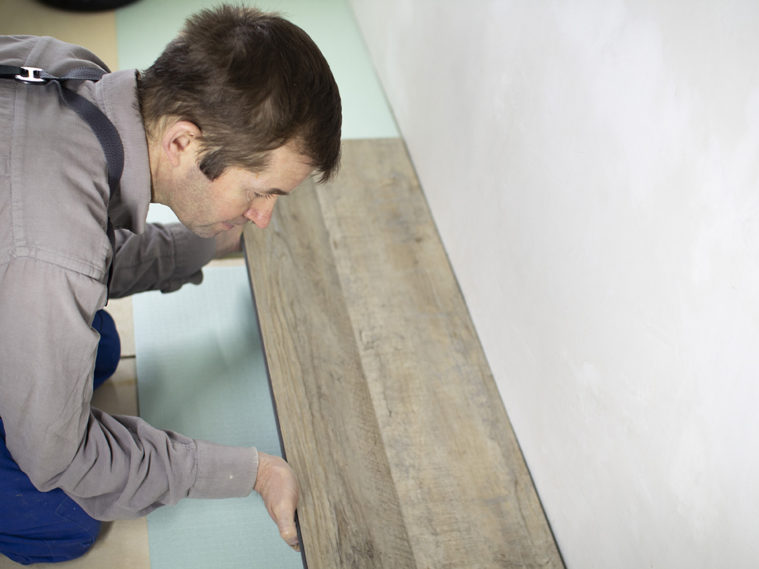
What Tools Do You Need to Install Your Own Luxury Vinyl Plank or Tile?
ShareOne of the benefits of luxury vinyl plank (LVP) and luxury vinyl tile (LVT) is its ease of installation. There are very few flooring materials a do-it-yourself home improvement enthusiast can easily tackle without making a significant investment in materials and equipment. Messing up a flooring installation, especially when using expensive flooring, can be costly.
Even relatively affordable flooring like carpet isn’t necessarily easy to install. You need install tack strips and to get the stretching (assuming you have a carpet stretcher) and stapling (…and a flooring stapler) right to ensure the carpet looks good, won’t pull up and doesn’t have nails or staples protruding up for bare feet to step on.
The installation of floating LVT and LVP doesn’t require any fancy equipment. A motivated DIYer might be able to install luxury vinyl flooring with little more than a utility knife, especially in small, simple rooms like bedrooms, mud rooms, or laundry rooms.
Subfloor Preparation
A potentially complicated part of flooring installation that’s frequently overlooked by DIYers is subfloor preparation. Prepping the subfloor is a particularly labor-intensive part of flooring installation, especially if you’re unfamiliar with the flooring installation process. Even minor dips or imperfections that are barely visible or indiscernible with the naked eye can result in an unstable or uneven flooring installation.
Some flooring materials are more forgiving of minor subfloor imperfections than others. Inception SPC floating waterproof flooring is one such flooring option.
What You Need to Install Floating LVT or LVP
The Flooring Material
On the relatively short list of materials you will need to install a Metroflor floating floor is the flooring itself. There are several important things to keep in mind when buying LVT or LVP for the purposes of DIY installation.
- Make sure all the boxes of tile or plank are from the same run number. Hang on to the run number in case you run short and need to order more to finish the job. That way you’ll be sure to get material from the same run. It’s a good idea to have your retailer come to your house and measure your room(s) so you don’t run out of flooring before you’re finished.
- Allow the flooring to acclimate at room temperature in the room where it’s being installed (50-degrees to 100-degrees Fahrenheit with humidity between 40 and 60 percent for 48 hours prior to installation)
Testing Tools
Depending on the substrate it may be necessary to run some tests prior to installation. For example, concrete should be tested for moisture with a calcium chloride test kit. You want a moisture vapor emissions rate (MVER) result below 8 lbs. per 1,000 sq. ft. in 24 hours. People installing over concrete should also get a ph test kit and make sure the alkalinity levels are between seven and nine.
If you’re installing a floating LVT or LVP floor over a wood substrate you can check for moisture using an invasive moisture meter. Even if the wood looks dry and you don’t see any signs of moisture, you should still run the test. Ideally the wood substrate should not exceed 14 percent moisture.
Tools to Ensure the Substrate Is Level
Although LVT/LVP floating flooring is more forgiving than other materials when it comes to substrates, it’s still important to install on a relatively flat substrate. You’ll want to ensure that the surface is flat within 3/16 of an inch in a 10-foot radius. The substrate shouldn’t slope more than one inch for every six feet. All you really need to test these figures is a tape measure and a level. If you want to span longer distances than your level will accommodate, you can use a straight 2x4 to identify any low spots. Make sure the 2x4 is visually straight and not bowed in either direction.
Your substrate might have large cracks or holes that need to be filled with a cement leveling and patching compound, which you can apply with a hand trowel.
If you’re pulling up carpet or vinyl that was either stapled down or secured with adhesive you will need to remove, scrape up or encapsulate the remnants before installing a floating floor. You might need some kind of a scraping tool to remove old adhesive or a hammer or prybar to yank out staples or nails.
Door Frames and Baseboards
You might also need a hand saw if you need to shave down the bottom of door casings or baseboards to ensure the floating floor can slip under these fixtures. You’ll need a roughly 1/4-inch expansion space between the substrate and the bottom of the door frame.
Tools for Installation
- Spacers to create an expansion space between the planks and the wall
- Razor for scoring luxury vinyl planks or tiles
- Combination square/carpenters square to ensure you’re making straight cuts
- The Prevail® tapping block and a hammer of some type – rubber mallets often work best
- Pull bar for securing the last row
That’s really all you need. Some people who have to make a lot of cuts, especially long cuts lengthwise on luxury vinyl planks, may want to use a table saw, but it’s not required.
Get Great Waterproof Floating Luxury Vinyl Flooring from Metroflor
It’s hard to imagine a flooring that’s easier to install than a luxury vinyl floating flooring. Where most flooring types require nails, staples, wet saws, and in the case of tile flooring lots of epoxy or adhesive, LVT and LVP floating floors only require a few basic hand tools.
Some types of Metroflor luxury vinyl flooring are installed with Prevail epoxy or adhesive, but even those installation methods tend to be much simpler and quicker than hardwood flooring or tile.
The only flooring that might be easier to install than floating flooring is Metroflor’s Déjà New with Attraxion™, which can be installed with nothing more than a utility knife and a chalk line. Once the magnetic underlayment has been rolled out, simply lay the LVP on top of the magnetic underlayment. Since the magnetic underlayment has a long life, you can remove the flooring and install a new LVT or LVP over the top of the underlayment. A new floor is simply a matter of peeling up the old plank or tile and putting a new one down.
You can learn more about Metroflor’s many easy-to-install flooring types on our website. Also be sure to visit our Prevail page for all the materials you’ll need to install Metroflor LVT and LVP. And if you want a retailer to come to your house to measure for your flooring material requirements, Metroflor has a dealer locator that allows you to search for your nearest Metroflor retailer.
Read the Latest Style News

Apr 23, 2024
Step into Spring: Revitalize Your Interior Design with Fresh Flooring Choices

Mar 15, 2024
Are There Different Types of Farmhouse Styles?

